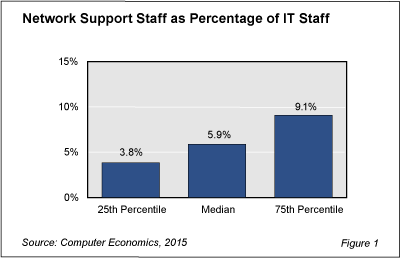In the age of cloud computing, the importance of networks cannot be overstated, yet the size of the network support staff as a percentage of the IT staff has remained relatively steady. The data suggests better technology, automation, and outsourcing are enabling IT organizations to absorb more technology without necessarily adding more people. Networking is a very scalable technology and that scalability extends to the maintenance and support function.
Figure 1 from our study on Network Support Staffing Ratios shows that, for the composite sample, the ratio of network support staff to IT staff is 5.9% at the median. The ratio ranges from 3.8% at the 25th percentile to 9.1% at the 75th percentile.

For benchmarking purposes we make adjustments to the data to account for outsourcing. IT organizations that outsource network support are asked to estimate how many positions they would have to add to their network support staff if they did no outsourcing. In addition, we report staffing benchmarks as percentiles rather than averages. While averages are useful for assessing trends over time, percentiles provide a range of values that can be used to benchmark an organization’s current staffing level. Percentiles also are not influenced by organizations that have exceptionally high or low staffing levels.
The median, or 50th percentile, is the point at which half the organizations have the same as or larger network support staff. The 25th percentile is the point at which 75% of the organizations have staffing levels that are the same as or higher. About half of all organizations fall within the range defined by the 25th percentile and 75th percentile. We consider organizations that fall within that range to be typical.
Organization size influences staffing ratios, and for benchmarking purposes, IT organizations should use our organization size benchmarks. The full study will help IT managers determine whether their organization is keeping pace with improvements in network management by comparing their network support staffing against industry benchmarks by organization size. We provide four benchmarks: network support staff as a percentage of the IT staff, network support staff as a percentage of the Network and Communications Group, network devices per network support staff member, and users per network support staff member.
In the study, network support staff includes personnel with titles that include the designations of engineer, architect, administrator, technician, specialist, or analyst for voice and data networks. The network support staff headcount does not include managers, but would include supervisors and senior-level personnel.
We place network support staff within a broader classification of the Network and Communications Group. We have three other staffing categories in the group, all of which should be excluded from the network support headcount for the purposes of using these benchmarks. These include communications system support staff, web/e-commerce staff, and security professionals.
This Research Byte is a brief overview of our report on this subject, Network Support Staffing Ratios. The full report is available at no charge for Computer Economics clients, or it may be purchased by non-clients directly from our website (click for pricing).
Do you also need staffing ratios for other IT job functions? Consider this collection of all of our staffing ratio reports, which bundles them all into a single report at a significant discount: IT Staffing Ratios–Special Report Bundle.

